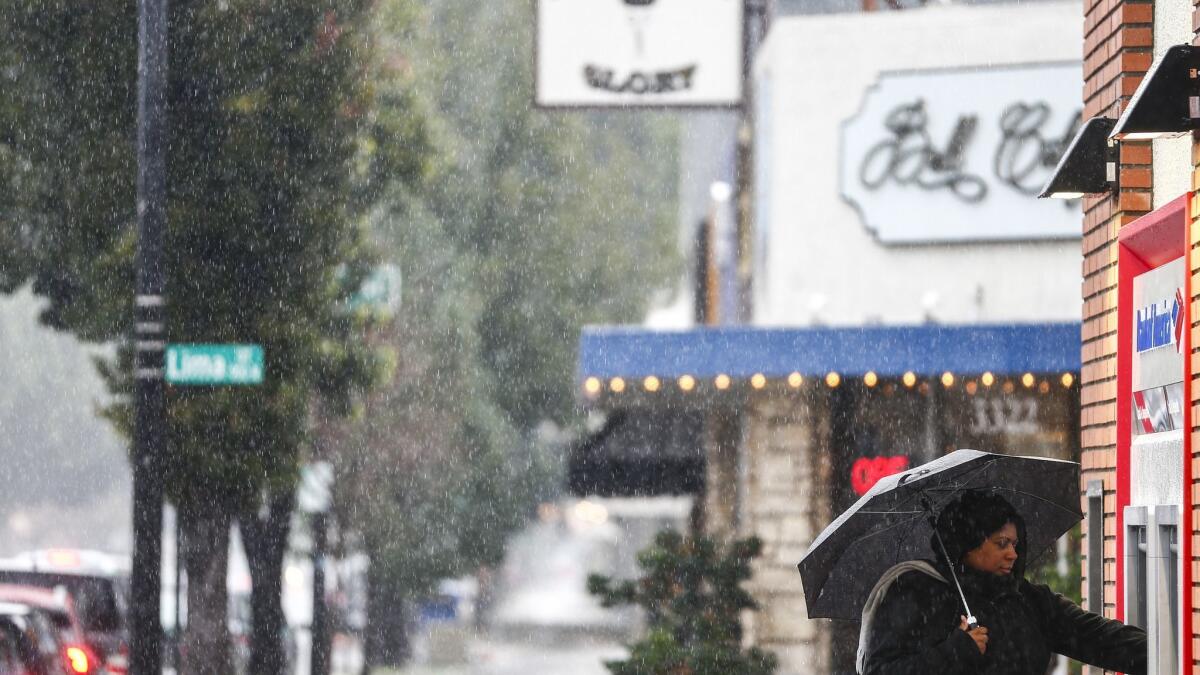New scale will measure atmospheric rivers in California from 1 to 5, like hurricanes

- Share via
Marty Ralph was sitting in a San Francisco restaurant a couple of years ago when the morning forecast came on the TV, showing the typical weather symbols indicating what the week ahead would bring: a sun, a cloud, a rainy cloud and a darker, more ominous rainy cloud.
Ralph, the director of the Center for Western Weather and Water Extremes, knew that at the end of the week, an intense atmospheric river storm was coming through the area. But he didn’t think the TV meteorologists could convey that very well with the icons on the screen. So he and a team of researchers got to work creating a ranking system that would be more helpful.
On Tuesday, researchers announced a new scale to describe the strength of atmospheric river storms, weather events that cause many of the West Coast’s heaviest rains.
Unlike other scales that focus on potential damage — such as the Fujita scale for tornadoes or the Saffir-Simpson scale for hurricanes — the atmospheric river scale will also characterize how beneficial storms can be for the water supply among California and other Western states, according to UC San Diego’s Scripps Institution of Oceanography. It was created in collaboration with the Department of Water Resources and the National Weather Service.
Atmospheric rivers are long, narrow bands of water vapor pushed by strong winds occurring over the Pacific Ocean. Stronger than typical storms, they account for a disproportionate amount of annual precipitation— between 30% and 40% — on the West Coast, Ralph said.
The new scale characterizes the intensity of atmospheric rivers — measured based on how fast the storm’s water vapor is flowing — from “weak” to “exceptional,” Ralph said.
Based on the storm’s intensity and duration, the weather event is given an overall category from 1 to 5. Under this system, Los Angeles’ most recent storm would be a Category 2 because it had a “moderate” intensity and lasted between one and two days, he said.
Researchers wanted to include rankings for weaker storms, which may not garner as much attention for the general public but can be important information for water managers.
The lower rankings indicate a storm is likely to be beneficial, offering modest rainfall that can result in several inches of rain and help replenish reservoirs, researchers said. Higher rankings label a weather event as potentially more dangerous and can indicate a potential for floods or destructive debris flows, especially in recent burn areas.
“[The scale] can serve as a focal point for discussion between water managers, emergency response personnel and the research community as these key water supply and flood inducing storms continue to evolve in a changing climate,” coauthor and state climatologist Michael Anderson said in a news release from Scripps.
Jon Rutz, a meteorologist with the National Weather Service, said in the news release he expects the scale will be widely adopted.
“The AR scale is a significant step forward, providing forecasters with a tool to distinguish between primarily beneficial and primarily hazardous storms,” he said, adding that it will help forecasters better communicate potential weather impacts to emergency officials, water managers and policymakers.
The researchers are working with the American Meteorological Society’s committee on broadcast meteorology to train weathercasters in using the new scale and explaining it to viewers, Ralph said.
When an atmospheric river is predicted, the Center for Western Weather and Water Extremes will now post its ranking on the AR scale on its website and Twitter account.
Twitter: @r_valejandra
More to Read
Sign up for Essential California
The most important California stories and recommendations in your inbox every morning.
You may occasionally receive promotional content from the Los Angeles Times.











